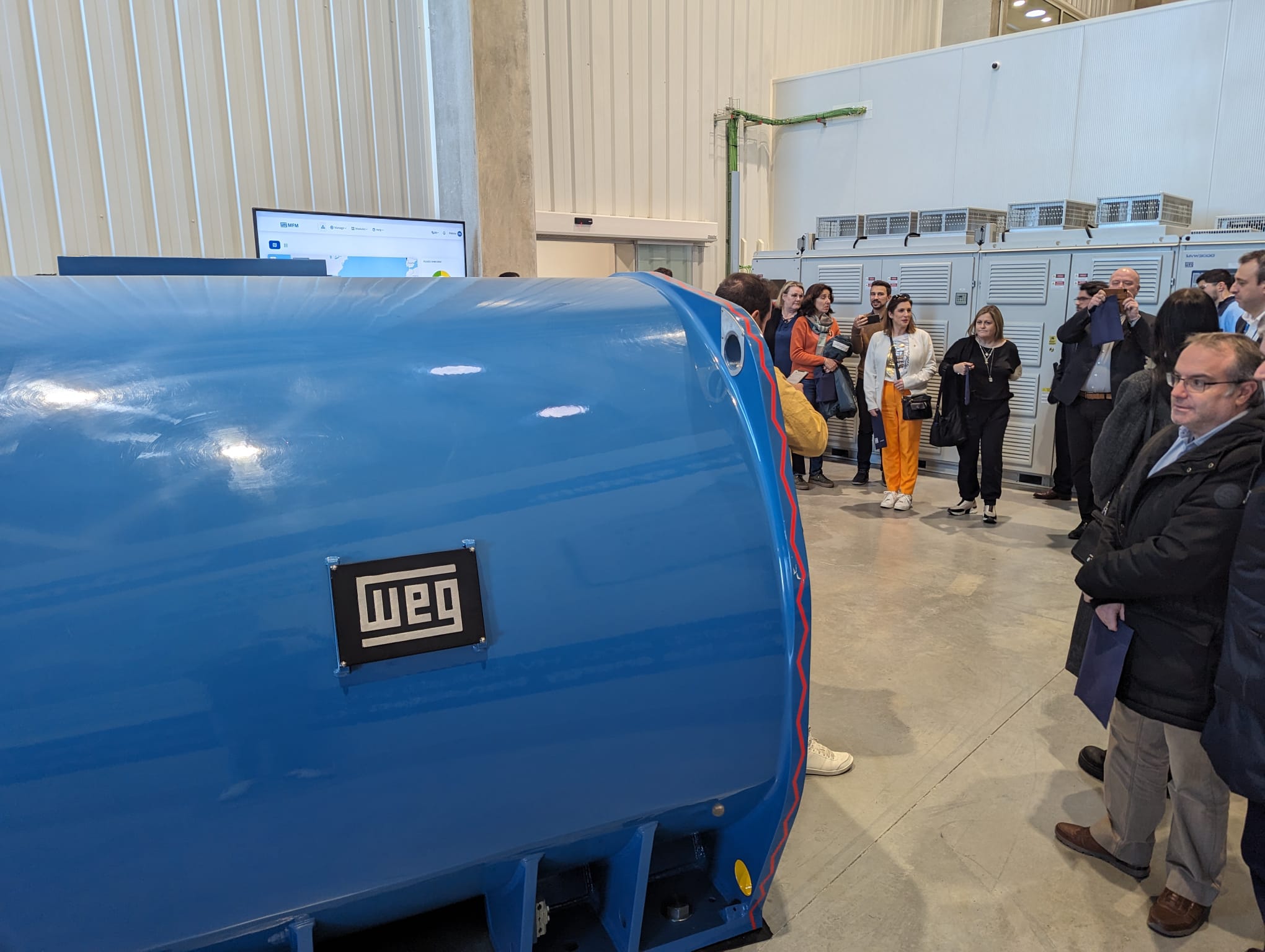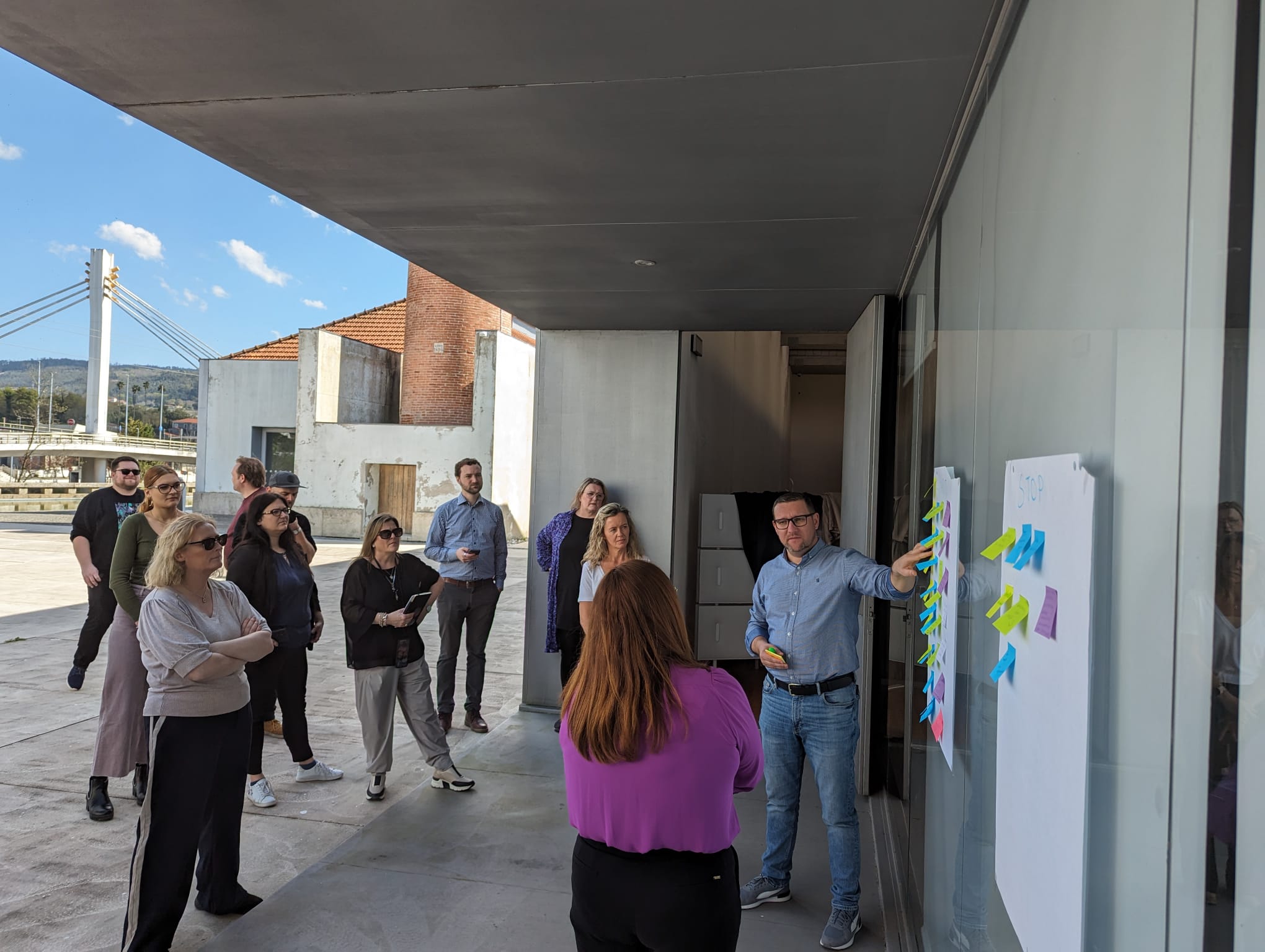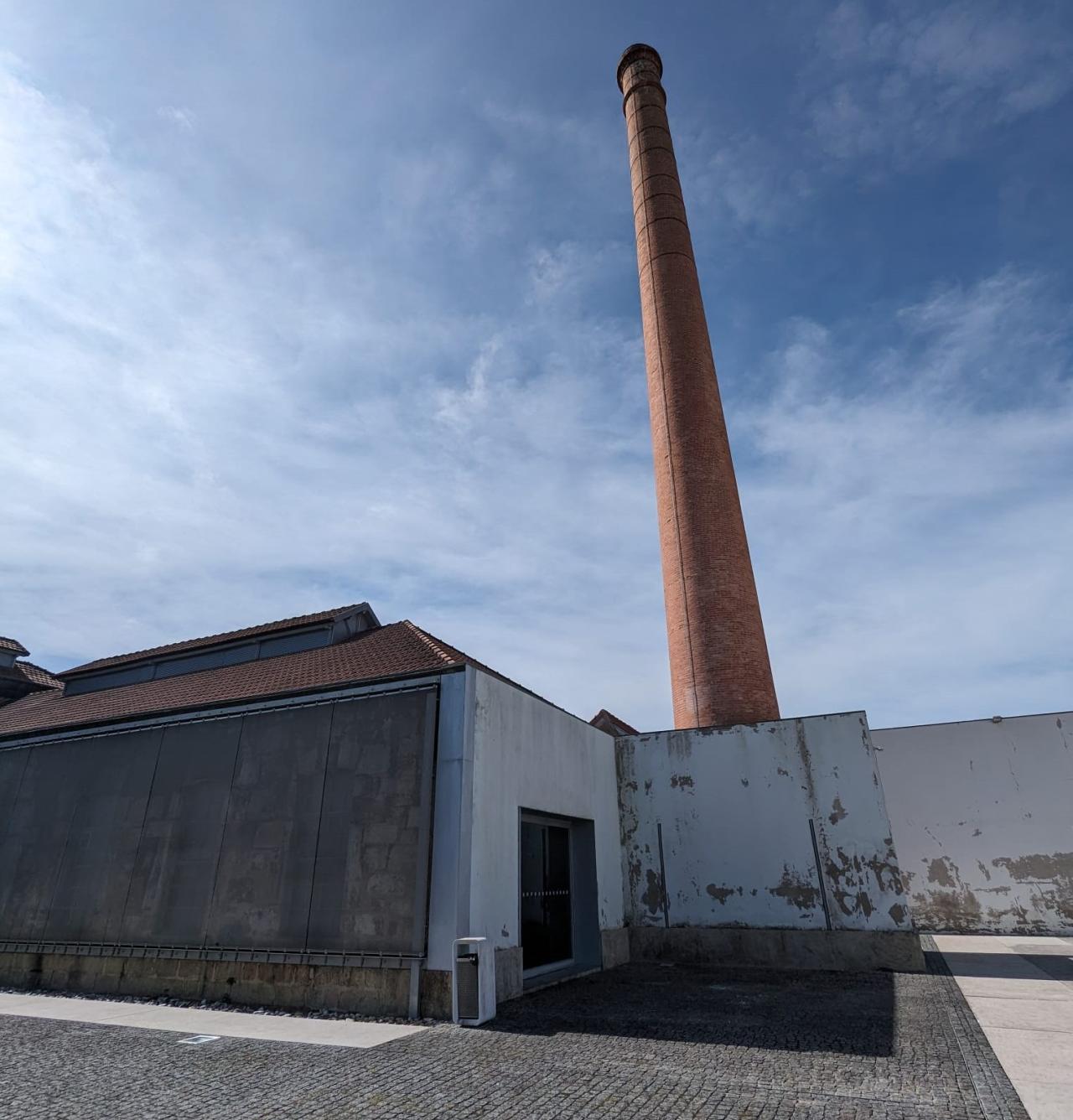Today, the partly renovated (43,000m2) factory symbolises a new industrial vision for the city, one that is not driven solely by economic gain but which can benefit the city’s social and environmental fabric too. Innovation and collaboration is key to making this a success and today the Fábrica acts as a multi-functional hub supporting collaboration and creativity across sectors.
The factory which is being renovated on phased basis, is home to and managed by Invest Santo Tirso, which was created in 2015 to act as a one stop shop for potential investors in the area and to support economic development in the city. It provides a modern work and business space, an educational, experimentation and innovation space, as well as a cultural, events and leisure space for the city and it was here that partners congregated for the second EcoCore core network meeting.
One of the key aims of the meeting was to reflect and share experiences on ensuring an integrated approach to action planning. Following the icebreaker Ms. Irina Rotaru, Project Officer from the URBACT secretariat reminded partners of the key aspects and importance of ensuring an integrated approach in action planning. She also reminded partners of the importance of the URBACT cross cutting themes of digitalisation, gender and diversity and the green transition.
Following this partners were invited to form six small working groups and to come together in their working groups around breakout tables equipped with markers, sticky notes and an integration grid.

Partners were asked to work together on completing the grid. Afterwards participants were asked to feedback to the wider group. Participants reported that they found the grid a helpful tool and that they would likely use it locally with their own teams and ULG to identify ways in which they could improve on their current approach to integration. Participants commented on the importance of ensuring that all aspects of the integrated approach were tackled locally to ensure sustainable development. From an EcoCore perspective however it was commented that the vertical and territorial aspects were vital in driving the strategic change required by EcoCore partners. Finally participants reflected on the common challenge of maintaining stakeholder engagement in a process where impacts often do not become visible in the short term and may sometimes not be felt for a period of ten years or more.
Moving on lead expert, Eileen Crowley presented a short summary of partner progress with data gathered from a survey previously circulated to and completed by partners. She reminded partners of the importance of the ULG as a vehicle for ensuring progress in the action planning process. More on partner activities and progress at the local level can be found in the following section.
Following the coffee break Vera Araújo from Invest Santo Tirso, supported by Aliados Consulting treated participants to a fun and interactive presentation delivered via a Mentimeter quiz, summarising industrial development and the innovation ecosystem in Santo Tirso.
This was followed by a visit to the Interpretive Centre in Fábrica Santo Tirso were partners were provided with a tour of the interpretive centre and a summary of the history of the space, the importance of the textile industry in the economic development of the region and it’s rebirth into the Fábrica Santo Tirso that is evolving today.
Following the lunch break, Mr. Rui Barros Garcia from the industrial development company García García, introduced participants to his role in developing industrial zones in Santo Tirso.
The development company García García, promote Santo Tirso (among other Portuguese cities) to potential investors looking to develop industrial spaces or locate their business in Portugal.
Invest Santo Tirso provides acts as a one stop shop for potential investors and offers them a suite of support services including:
• Information and support and ongoing monitoring of investment projects in the municipality relating to industry, commerce, tourism and rural development;
• Promoting business parks;
• Information and reception of requests from potential investors, to obtain the status of “Project of Municipal Interest”;
• Information on Incentive Systems available within the framework of Portugal 2020;
• Promotional activities in the areas of tourism and cultural and creative industries;
• Promoting rural development;
• Promoting the assets and initiatives that make up the Fábrica de Santo Thyrso, a hub for Fashion and Cultural and Creative Activities and Industries.
Once a suitable site is identified and all licensing requirements fulfilled, García García provide a design and build service to the investor.
They also play a role in the management of industrial parks and Rui highlighted the importance of data collection since one can’t manage what they don’t measure. He provided some interesting practical examples including for example the role of data collection and analysis in convincing the LIDL distribution centre to relocate to Santo Tirso from a nearby city. In this instance, a simple calculation of distance and fuel used getting to/from key transport corridors was critical in showcasing the Co2 footprint reduction enabled by the relocation. Rui reminded participants that the ability to provide practical examples of how a company’s Co2 footprint can be reduced based on a particular location’s attributes, will play an increasingly important role in attracting new businesses to a particular city.
Following the presentation by Rui participants took a bus to La Hermida business zone, one of the newest industrial parks in the city. There, participants visited the WEG facility, where motors and drives are manufactured for the global market. A presentation was delivered focussed on the company’s sustainability strategy and with a focus on how the company is driving the green transition. While the company is taking multiple actions to tackle it’s internal carbon footprint it has not yet embarked on promoting a reduction in the carbon emissions of its value chain. This will be the next step in its sustainability strategy.

The company’s real time motion fleet management system was also showcased, highlighting the role of digitalisation in driving the green transition with industry. The software enables a proactive rather than a reactive approach to the maintenance and management of their machinery and assets. This means increased efficiency and the possibility to identify ad rectify faults before they happen, saving the business operational losses and lengthening the lifespan of operating machinery.
A key reflection arising from the visit was the fact that while businesses are taking steps to reduce their carbon footprint internally there is a lot of untapped potential to drive carbon footprint reduction through facilitating matchmaking and collaboration between businesses. Partner cities can reflect on what role they could play in this regard. The network will seek to gather good practices on this topic during the workshop on green and smart business parks planned for the core network meeting in Villena in November.
The morning of the second day of the core network meeting provided time for participants to reflect on the learnings and key messages from the previous day. Participants noted the following takeaways and reflections.
• All five overarching aspects of the integrated approach, are critical to ensuring sustainable action planning and development. Vertical and territorial integration are of key strategic importance to this network.
• Fábrica Santo Tirso - a good example of reimagining industrial heritage to become hubs for innovation, collaboration, creativity and economic development better aligned with the green and just transitions
• Public Private Partnerships (Garcia Garcia & Invest Santo Tirso) driving industrial development supported by fast tracking development licencing through the projects of municipal importance
• Trust, relationship building, speedy communication and municipality staff with an entrepreneurial mindset are key to attracting investment.
• The municipality can provide a valuable communication channel between businesses and national department responsible for enterprise development. The Mayor can play a key role here.
• While businesses are taking steps to reduce their carbon footprint internally there is a lot of untapped potential to drive carbon footprint reduction through facilitating matchmaking and collaboration BETWEEN businesses. What role for municipalities here?
• You can’t manage what you don’t measure. Data collection and analysis is an essential pre-requisite for driving green transition e.g. promoting car-pooling within industrial zones, modal analysis to develop sustainable mobility plans, analysis of material flows to promote industrial symbiosis. The municipality (and academia) can play a role here.
• Being able to provide practical examples of how you can reduce a company’s Co2 footprint will play an increasingly important role in attracting new businesses to your city. Santo Tirso convinced LIDL distribution centre to relocate to Santo Tirso from a nearby city through this method based on simple calculation of distance and fuel used getting to/from key transport corridors.
Following this Vera Araújo presented the branding & marketing strategy that promotes Santo Tirso as a location for industrial investment. Key points of the strategy in Santo Tirso are as follows:
• Identifying the strengths that differentiate Santo Tirso from other municipalities
• Developing a name and brand that is easily recognisable (Invest Santo Tirso)
• Identifying marketing channels (fairs, social media, press and advertising campaigns) and adopting strategies to promote Santo Tirso as a destination for industrial investment
• Developing partnerships with cross sectoral stakeholders that can help promote Santo Tirso as an attractive location for industrial investment

Before the coffee break, Vera Araújo and Rafael Silva presented on sustainable mobility & transport initiatives in Santo Tirso and the wider metropolitan area. They reflected on the importance of taking an integrated approach and in the case of Santo Tirso the need to gather data on the transport needs and habits of the metropolitan population and to use identify opportunities to build critical mass and build the business case for alternative transport modes and public transport routes and schedules.
While the private car is by far the preferred and dominant mode of transport in Santo Tirso and the wider metropolitan area, the city, in partnership with neighbouring municipalities and public transport providers, is developing an integrated ticketing system to be rolled out across the metropolitan area in an effort to increase the use of public transport modes. The city is also investing over €8 million in cycling infrastructure and providing a city bike sharing scheme. A dry port or commercial rail freight terminal is planned for development in the neighbouring city of Vila Nova de Famalicão, when developed it will be the largest private rail freight operator on the Iberian Peninsula.
Following the coffee break, the meeting turned its attention to the URBACT cross cutting theme of gender and diversity. The session kicked off with a presentation by Ms. Inês Santos Silva, Co-founder and Chief Activist at Portuguese Women in Tech, a community focused on attracting more women to tech and supporting those already working in the industry. Inês reflected on the importance of promoting gender equality and diversity in the workforce noting that it is in the interest of business. She also shared some data to back up this assertion.
McKinsey & Company’s Global Institute report found that narrowing the gender gap could add between $12 and $28 trillion to the global GDP. According to Harvard Business Review, diverse management teams are 70% more likely to capture new markets. In addition gender diversity can increase profitability by 5-20%. This provided food for thought for all of the participants, which included ULG members from Santo Tirso, to consider what role they could play in promoting greater gender equality and diversity in the drive towards the green transition.
The meeting broke for lunch before regrouping in the afternoon to undertake the Start, Stop, Continue exercise. During this activity participants worked in small groups to reflect on what had been shared about Santo Tirso throughout the meeting. Acting in the role of ‘critical friend’ they were asked to provide feedback to their Santo Tirso peers to be categorised within the areas of ‘start’, ‘stop’ and things they should ‘continue’ doing by writing them on sticky notes before reporting back a summary to the group.
After two action packed days, partners spent the evening enjoying a cultural visit to a local monastery before enjoying a tree top sunset from the heights of Santo Tirso.


